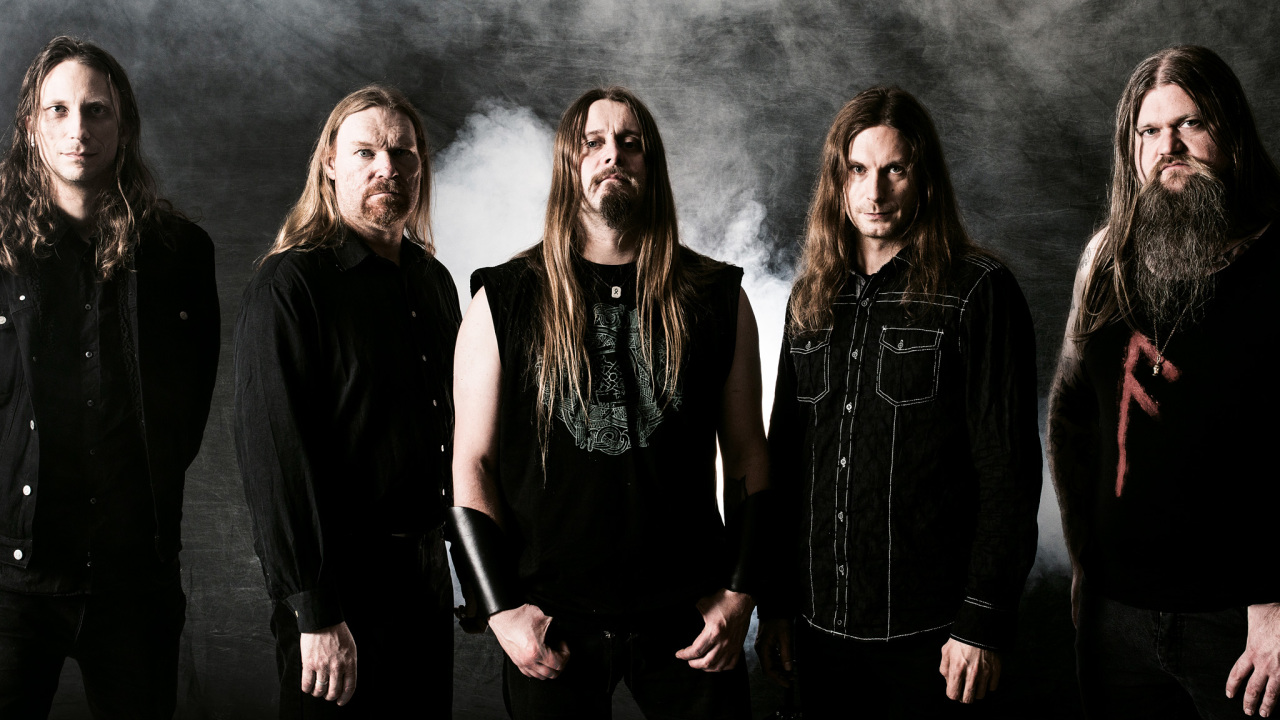“We drove as far as we could, filled up a wagon with our recording equipment and just starting walking,” says Ivar Bjørnson, guitarist and songwriter for Enslaved.
“Being from the west coast of Norway, we are surrounded by these folkloric forests in the mountains and after being in a sterile studio environment, working really hard and staying focused, we felt that it was time to introduce a little bit of chaos.”
Bjørnson is speaking about the creation of the band’s recently released 13th studio album, In Times. It was recorded in just three weeks and features experimental sounds captured deep in the woods of Valevåg, south of Bergen, where they set up a mobile studio. Bjørnson recounts the enlightening – and sometimes quite humorous – recording experience.
“Since I’m the biggest dude in the band, my job was to pull the cart, like some kind of an ox,” he explains. “Needless to say that it fell over a couple of times. It was already late into the night when we found the cottage. Then for the entire weekend, we worked on the music, drank some beers, slept a little bit in between, then drank some wine and worked some more.”
The resonance of nature’s contrasting elements such as fire and water are echoed throughout the album. The atmospheric One Thousand Years Of Rain suitably features the sound of rainfall, and a blazing campfire can be heard during the start of second track Building With Fire. These additions give the songs a gentle, organic feel, perfectly accompanying the band’s increasingly progressive yet still crushingly heavy sound.
“It seems like something a band with early black metal roots would do,” admits Bjørnson, “but there’s a whole lot of silliness linked to those days. However, there is something very valuable that we learnt from that time and that is to take art seriously.”
The main theme explored on In Times is certainly a serious and complex one: metaphysical exploration and wonder surrounding the concept of time. Through examples of time-lapse and mythological research, Bjørnson explains how he developed the album’s focal point.
“It started out with some weird science programme I watched, where a guy was explaining that when you measure time close up and far away from a solid object like a pyramid, the watches begin to show different times because of the effect of gravity,” he explains. “There’s something interesting about how time is portrayed in different meetings with that concept. This got me thinking about synchronicity and whether my subconscious was telling me to look more into these things.”
The album cover was hand-painted by long-time collaborating artist and “sixth Enslaved member” Truls Espedal. It depicts a powerful image of two large figures walking across peaceful waters towards an infinite, deep-red horizon. Bjørnson explains that the figures are similar to the giants from northern mythology, who are said to be representatives of the subconscious through their chaos and unruliness. These creatures are mentioned in the title track’s lyrics as the giants of the night side, guarding the oceans of time.
“These large figures are roaming free agents, and also the sources of energy and creativity,” says Bjørnson. “They could represent a barrier between something deeper and what is on the surface. On a larger scale, this can apply to pretty much everything, including the mind: common subconsciousness and the human psyche. In nature, it is the division between order and chaos.”
Enslaved’s interest in the balance between order and chaos is one that manifests itself in their music, and the effectiveness of In Times stems from the potential for stability that these contrasts create. With their rich blend of psychedelia, metal, melody and prog, Enslaved are, as Bjørnson states, an entity of their own, driven by the duality of prog and metal.
“Things come in pairs all the time. When it comes to our albums, the concepts, the lyrics, there is always a balance with us,” he explains. “Some bands are into just being a live band or they prefer the studio. With us, when we are in the studio, we really want to go on the road and when we are on the road, we really want to be in the studio. I guess it’s the same when we are doing this long, prog, Pink Floyd-ish music, and then we start itching to go back to blasting it out a little bit. It’s a balance achieved by bouncing back and forth.”
As for influences, Bjørnson’s are wide and varied, and he cites Dalí’s famous melting clocks and altered mirror reflections as part of his artistic inspiration for the album. With sonic influences, he’s certainly open-minded.
“I’m surprised when I read that some younger bands say that they are not influenced by other music. I just don’t see how that’s even possible. There is so much good music coming out these days, and when it comes to my prog influences… well, that’s yet another direction in time and it’s never-ending. You can easily work your way back through time to all of the prog classics, like Genesis, Yes, Rush and Pink Floyd.”
More recently, however, his inspirations stemmed from another band in a similar genre. “I’ve been listening a lot to the guitarist Allan Holdsworth because, to be honest, I was trying to figure out where the guitarist from Meshuggah was getting all of his weird scales from. That’s how it works – you have to keep looking out for any arrows pointing to a new musical influence and discovery.
“When we started, we built our own core and extreme metal sound. We weren’t exactly part of the black metal scene but more related to it. We were inspired by the same things and we had the same influences. But we also had all of this love for different kinds of music, especially 1970s prog and experimental stuff, as well as jazz and classical. Basically, any kind of music that would make us react.”
The band’s popularity has remained intact throughout their career, despite a few revolts on various internet forums from fans fervently worshipping their early extreme opus, 1994’s Frost, and wishing that Enslaved would return to that style.
“It was obvious that a lot of our fans would really love Frost rather than our prog albums, and so a few of them think we should continue being the way we were at the start, but I guess those people will disappear at some point anyway. Dogmatic people tend to lose interest in whatever you do.
“We always hang out at the merchandise booth and talk with people,” Bjørnson adds. “Some people would tell us they could only listen to our old albums and not the new stuff, but we just thought, ‘Well, hey, that’s great too.’ Time is linear, things change.
“You don’t have to listen to our two latest releases to be a proper Enslaved fan. We tried to maintain an open line of communication. A lot of fans stayed with us. In fact, some people even checked out some of our influences and got turned on to prog by trying to understand what made us change. It’s all about communication.”
In Times is out now on Nuclear Blast. For more information, see http://www.enslaved.no.

